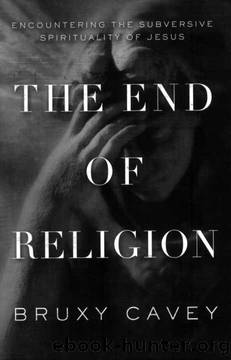The End of Religion: Encountering the Subversive Spirituality of Jesus by Bruxy Cavey

Author:Bruxy Cavey
Language: eng
Format: mobi
Tags: Christian
ISBN: 9781600060670
Published: 2007-08-29T23:00:00+00:00
I appeal to you therefore, brothers and sisters, by the mercies of God, to present your bodies as a living sacrifice, holy and acceptable to God, which is your spiritual worship.
- ROMANS 12:1, NRSV
CHAPTER TWELVE
Subversive Symbols
What is essential Christianity! From first to last it is scandal, the divine scandal. Every time someone risks scandal of high order there is joy in heaven.
- SOREN KIERKEGAARD
When Jesus died he was relatively young, compared to other potential world-changing figures. At their respective deaths, Muhammad was sixty, Socrates was seventy, Plato and Buddha were both more than eighty, and Moses was one hundred twenty! Christ's death came so comparatively early in his messianic career (probably in his early thirties) that we really only have about three years of his adult life on record. It is amazing that he left the impact he did on human history, more than any other figure that has ever lived.
What we know about Jesus' teaching is as bizarre as it is beautiful. Jesus didn't just teach about God, life, and salvation; he taught about himself and how he could help us connect with God. Jesus saw himself as a conduit to the divine. Specifically, he taught that his death would somehow be the key to making that connection real (see Matthew 16:21- 25; Luke 18:31-34).
Jesus communicated his message, not only through his stories and teachings, but also by reconfiguring significant symbols of his day. Before he died, Jesus left his followers with two symbols of subversion, acts of irreligion, which have survived to this day, albeit often in very religious forms.
'I be first was baptism. When people went to the temple to receive forgiveness for their sin, they not only sacrificed animals, but also cleansed themselves ritually with water. They would baptize (from the Greek word meaning "to immerse") themselves in basins of water designed to help them wash away any spiritual impurities they had come in contact with during their daily lives. Between full-body baptisms, many religious people would baptize their hands to symbolize their commitment to purity (remember the sacred jars at the wedding in Cana).
In partnership with John the Baptist, Jesus adopted this symbol but moved it away from the temple steps and into the community, wherever water was available. Baptism into the Jesus movement became a way of symbolizing that people could have their sins washed away, apart from the religious system. This renewed symbol did not take a special priest or pastor to administer. Instead, any spiritual brother or sister could baptize the person coming into faith as a way of partnering with him in the symbol and welcoming him into the spiritual community (see Acts 8:26-39). As well, the symbol became a single event at the outset of a person's life of faith. Recurring baptisms became unnecessary because baptism was no longer part of a system of ritualistic purification. A onetime baptism symbolized God's once-and-for-all acceptance of us. The simplicity of the symbol is beautiful. Unfortunately, many Christians use baptism today as the
Download
This site does not store any files on its server. We only index and link to content provided by other sites. Please contact the content providers to delete copyright contents if any and email us, we'll remove relevant links or contents immediately.
The Lost Art of Listening by Michael P. Nichols(7409)
Why I Am Not A Calvinist by Dr. Peter S. Ruckman(4103)
The Rosicrucians by Christopher McIntosh(3467)
Wicca: a guide for the solitary practitioner by Scott Cunningham(3127)
Signature in the Cell: DNA and the Evidence for Intelligent Design by Stephen C. Meyer(3071)
Real Sex by Lauren F. Winner(2968)
The Holy Spirit by Billy Graham(2893)
To Light a Sacred Flame by Silver RavenWolf(2768)
The End of Faith by Sam Harris(2691)
The Gnostic Gospels by Pagels Elaine(2472)
Waking Up by Sam Harris(2392)
Nine Parts of Desire by Geraldine Brooks(2326)
Jesus by Paul Johnson(2310)
Devil, The by Almond Philip C(2282)
The God delusion by Richard Dawkins(2265)
Heavens on Earth by Michael Shermer(2238)
Kundalini by Gopi Krishna(2137)
Chosen by God by R. C. Sproul(2123)
The Nature of Consciousness by Rupert Spira(2047)
